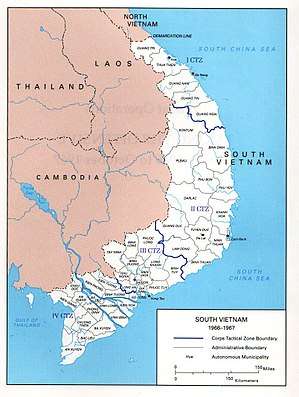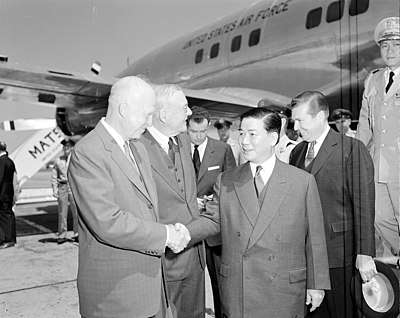1957 in the Vietnam War
In 1957 South Vietnam's President Ngô Đình Diệm visited the United States and was acclaimed a "miracle man' who had saved one-half of Vietnam from communism. However, in the latter part of the year, violent incidents committed by anti-Diệm insurgents increased and doubts about the viability of Diệm's government were expressed in the media and by U.S. government officials.
| 1957 in the Vietnam War | |||
|---|---|---|---|
 A map of South Vietnam showing provincial boundaries and names and military zones (1, II, III, and IV Corps). | |||
| |||
| Belligerents | |||
|
|
Anti-government insurgents: | ||
The term "Viet Cong" for the communist cadres in South Vietnam began to replace the older term "Viet Minh" in common usage.
January
The military budget for the government of South Vietnam in 1957 was projected to total $207 million dollars of which $187 million would come from the United States. Seventy percent of the U.S. assistance was spent paying the salaries of South Vietnamese armed forces.[2]
An author in the prestigious American Journal Foreign Affairs said that "South Vietnam today is a quasi-police state characterized by arbitrary arrests and imprisonments, strict censorship of the press and the absence of an effective political opposition.[3]
- 3 January
The International Control Commission, formed to administer the Geneva Accords of 1954, said that neither North or South Vietnam had been in compliance with the agreement.[4]
February
- 22 February
A shot was fired which narrowly missed Diệm while he was visiting Ban Mê Thuột. He was not injured but his Secretary of Agrarian Reform was wounded.[5]
April
- 30 April
A CIA National Intelligence Estimate said that the Viet Cong in South Vietnam numbered 5,000 to 8,000 and along with about 2,000 armed members of the Cao Đài and Hòa Hảo sects were "widely dispersed and probably not capable of more than local harassment of government forces and local populations."[6]
May
The Civil Police Administration project of Michigan State University surveyed the police and para military resources of South Vietnam. The para-military Civil Guard (CG) had 54,000 members and was responsible for patrolling rural areas and maintaining law and order. The Self Defense Corps (SDC) militia with about 50,000 members was a militia force to protect villages from subversive activities. These two organizations were poorly equipped, trained, and disciplined, especially the SDC whose "capability to withstand assaults by armed and organized Viet Cong units is virtually nil." In addition, in many areas the SDC was infiltrated by the communists.[7]
- 2 May
A new U.S. Ambassador in South Vietnam, Elbridge Durbrow warned the Department of State that Diệm had "become more intolerant of dissenting opinions" and that he relied "heavily on a small circle of advisers including members of his family."[8]

- 8 May
On an official visit to the United States, President Diệm arrived at noon on May 8 at the National Airport in Washington, D.C. aboard the plane of U.S. President Dwight D. Eisenhower,[9] the Columbine III, a silver Constellation.[10] Diệm was received at the airport by Eisenhower, Secretary of State John Foster Dulles and Chairman of the Joint Chiefs of Staff Nathan Twining.[10] It was only the second time that Eisenhower had greeted a visitor at the airport.[9]
- 9 May
Diệm addressed the United States Congress and received a standing ovation.[11]
- 12 May
Diệm was accorded a ticker tape parade in New York City and acclaimed by Mayor Robert Wagner as "a man history may yet adjudge as one of the great figures of the twentieth century."[12]
- 13 May
Life Magazine called Diệm "The Tough Miracle Man of Vietnam." He was similarly lauded in other U.S. publications.[13]
- 19 May
Diệm departed the United States to return to South Vietnam. This date was also Ho Chi Minh's birthday.[14]
- 24 May
The number of U.S. military personnel in South Vietnam was increased from 692 to 736, the great majority being assigned to the Military Assistance Advisory Group (MAAG).[15]
June
Lê Duẩn, Secretary General of the Communist Party in North Vietnam, wrote a report advocating for North Vietnam to do more to support the communists, now commonly called the Viet Cong, in South Vietnam while continuing to focus on building a socialist society in the North.[16]
July
- 11 July
The relative peace in South Vietnam during the past year was broken when anti-government dissidents killed 17 people in a bar in the Châu Đốc massacre. The massacre was attributed to remnants of the Hòa Hảo religious sect which had been repressed by Diệm in 1955 and 1956.[17] The killings were the beginning of a low level campaign targeting government officials, school teachers, and village chief's families.[18][19]
- 15 July
South Vietnam's ambitious land reform program had only distributed 35,700 hectares (88,000 acres) to 18,800 farmers during nearly two years of operation. This compared with nearly 1,000,000 hectares (2,500,000 acres) of land estimated to be available for redistribution.[20]
September
- 2–9 September
The Ngô Đình Diệm presidential visit to Australia.[21]
- 14 September
The District Chief of Mỹ Tho Province and his family were assassinated.[22]
October
- 10 October
A bomb was thrown into a Saigon restaurant and injured 13 people.[22]
- 21 October
Major Harry Griffith Cramer, Jr. an American army officer, was killed by a bomb near Nha Trang, South Vietnam. It is unclear whether or not the bomb explosion was purposeful.[23]
- 22 October
Thirteen American soldiers were injured in three attacks aimed at MAAG and United States Information Service installations in Saigon.[22]
November
- 25 November
An article by David Hotham in The New Republic said that "We should not suppose that the Communists have done nothing because Diệm has been in power" but "rather than Diệm has remained in power because the Communists have done nothing." The Diệm government, he said, was not democratic; there was no freedom of the press; and the regime was propped up by American aid.[24]
December
Russian and Chinese ministers Nikita Khrushchev and Chou Enlai decided that South and North Vietnam should be regarded as separate countries and each have a seat at the United Nations.[25] This prompted the North Vietnam government to consider a military solution to unite North and South Vietnam.[25]
During the last three months of 1957, 190 terrorist attacks and clashes between government security forces and insurgents were reported in South Vietnam. Seventy-four people were killed including 20 government officials and 31 police and military personnel.[26]
- 5 December
Ambassador Durbrow in Saigon reported to the Department of State that Diệm's focus on security and repression of opposition to his rule was alienating the people of South Vietnam and facilitating the growth of communism.
- 10 December
General Samuel Williams, the head of MAAG in South Vietnam responded to Ambassador Durbrow. "There are no indications of a resumption of large-scale guerrilla war at this date", he said. The Viet Cong "lack sufficient strength, do not have a popular base and are faced with a central government whose efficiency to deal with the subversion threat has gradually improved." [27]
- 17 December
A Saigon newspaper highlighted the growing violence in the countryside of South Vietnam: "Today the menace is greater than ever, with the terrorists no longer limiting themselves to the notables in charge of security. Everything suits them, village chiefs, chairmen of liaison committees, simple guards, even former notables...In certain areas the village chiefs spend their nights in the security posts, while the inhabitants organize watches."[28]
- 31 December
In 1957, the anti-communist campaigns of the Diệm government decimated the communists in South Vietnam. 2,000 suspected communist party members and sympathizers were killed and 65,000 were arrested. Communist party membership in South Vietnam was 5,000 in mid-1957 and had been reduced to one-third that by the end of the year. According to a North Vietnamese historian, 1957 was "the darkest period" for the communist movement in South Vietnam.[29]
Annotations
- Thousands of Viet Minh cadres had stayed behind after the Vietnam was split into North and South Vietnam. The North Vietnamese government still held out that a referendum on unification as per the Geneva Accords would go ahead. As such they forbid the southern Viet Minh cadres from anything but low level insurgency actions instead issuing directives to focus on political agitation in preparation for the upcoming elections.[1]
Bibliography
- Notes
- Pentagon 1971, pp. 314–346
- Spector, Ronald H. United States Army in Vietnam: Advice and Support: the early years, 1941-1960 Washington: Government Printing Office, 1983, pp. 306-307
- Pentagon Papers, Gravel Edition, Vol 1, Chapter 5, "Origins of the Insurgency in South Vietnam, 1954-1960", Boston: Beacon Press, 1971
- Daugherty, Leo (2002), The Vietnam War Day by Day New York: Chartwell Books, Inc., p. 17
- "Vietnam Timeline: 1956-1957" http://www.vietnamgear.com/Indochina1956.aspx, accessed 12 Aug 2014
- "Agrarian Reform and Internal Security in South Vietnam", Central Intelligence Agency, accessed 25 Nov 2014
- Spector, pp. 320-321
- Logevall, Frederik Embers of War: The Fall of an Empire and the Making of America's Vietnam New York: Random House, 2012, p. 679
- Jacobs 2006, p. 102
- Jacobs 2006, p. 217
- Jacobs (2006), p. 256
- Jacobs (2006), p. 259
- Jacobs (2006), p. 252
- Jacobs (2006), p. 261
- http://www.Vietnamgear.com/Indochina1956.aspx, accessed 12 Aug 2014
- Logevall, 688
- Spector,p. 313
- Joes 2001, p. 50
- Langer 2005, p. 52
- Fall, Bernard "South Viet-Nam's Internal Problems" Pacific Affairs, Vol 31, No 3 (Sep 1958), p. 251. Accessed 14 Aug 2014 -- via JSTOR (subscription required)
- Ham 2007, p. 57
- Logevall, p. 684
- "West Point" http://www.west-point.org/users/usma1946/15816/, retrieved 14 Aug 2014
- Mann, Robert, A Grand Delusion: America's Descent into Vietnam New York: Basic Books, 2001, p.212
- Donaldson 1996, p. 88
- Spector, p. 315
- Logevall, p. 686; Spector, p. 316
- Fall, p. 257
- Duiker, William J. (1996), The Communist Road to Power in Vietnam, Boulder, Colorado: Westview Press, p. 196
- References
- Donaldson, Gary (1996). America at war since 1945: politics and diplomacy in Korea, Vietnam, and the Gulf War (1996 ed.). Greenwood Publishing Group. ISBN 978-0-275-95660-8.CS1 maint: ref=harv (link) - Total pages: 229
- Ham, Paul (2007). Vietnam: the Australian War. Pymble, New South Wales: Harper Collins. ISBN 978-0-7322-8237-0.CS1 maint: ref=harv (link)
- Jacobs, Seth (2006). Cold War Mandarin: Ngô Đình Diệm and the Origins of America's War in Vietnam, 1950–1963. Lanham, Maryland: Rowman & Littlefield Publishers. ISBN 0-7425-4447-8.CS1 maint: ref=harv (link)
- Joes, Anthony James (2001). The war for South Viet Nam, 1954-1975 (2001 ed.). Greenwood Publishing Group. ISBN 978-0-275-96806-9.CS1 maint: ref=harv (link) - Total pages: 199
- Langer, Howard (2005). The Vietnam War: an encyclopedia of quotations (2005 ed.). Greenwood Publishing Group. ISBN 978-0-313-32143-6.CS1 maint: ref=harv (link) - Total pages: 413
- Pentagon (1971). "Origins of the Insurgency in South Vietnam, 1954-1960". Pentagon Papers. Beacon Press. 1 Chapter 5 (Section 3): 314–346. Retrieved May 4, 2010.CS1 maint: ref=harv (link)